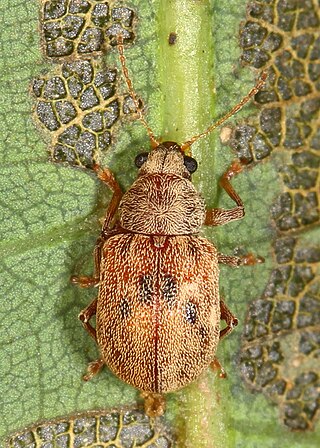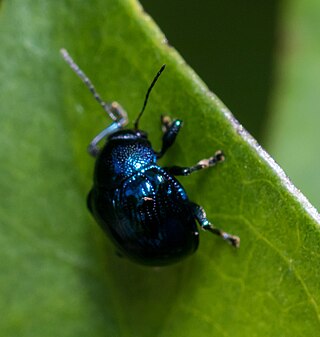
Platycorynus is a genus of leaf beetles in the subfamily Eumolpinae. Species of the genus are found in Africa and Asia.
Ennodius murrayi is a species of leaf beetle of Guinea, Ivory Coast, Nigeria, Cameroon, Equatorial Guinea, the Republic of the Congo and the Democratic Republic of the Congo, described by Félicien Chapuis in 1874.

Colaspoides is a genus of leaf beetles in the subfamily Eumolpinae. It is one of the largest genera in the subfamily, containing over 260 species worldwide. It is an extant genus but there is at least one species, C. eocenicus, found in Baltic amber from the Upper Eocene of Russia, and the genus has also been reported from the Miocene of the Dominican Republic.

Macrocoma is a genus of leaf beetles in the subfamily Eumolpinae. It contains about 100 species, which are found in tropical Africa, around the Mediterranean, on the Canary Islands, in western and central Asia, and in India.

Demotina is a genus of leaf beetles in the subfamily Eumolpinae. There are over 50 described species in Demotina. The genus is native to Asia, Australia and Oceania, though one species is an adventive species in the southeastern United States in North America. Some species are known to be parthenogenetic.

Typophorini is a tribe of leaf beetles in the subfamily Eumolpinae. The tribe contains approximately 100 genera, which are found worldwide. Members of the tribe are mainly characterized by notches on the tibiae of the middle and hind legs, which are sometimes referred to as antenna cleaners. They also generally have a subglabrous body, as well as bifid pretarsal claws.
Hyperaxis is a genus of leaf beetles in the subfamily Eumolpinae. It is distributed in East and Southeast Asia.
Tricliona is a genus of leaf beetles in the subfamily Eumolpinae. It contains at least 35 species, and is distributed from India and Southern China to the Philippines and New Guinea.

Eurydemus is a genus of leaf beetles in the subfamily Eumolpinae. It is known from Africa and Fiji.

Basilepta is a genus of leaf beetles in the subfamily Eumolpinae. It is generally distributed in Asia. A single species is also known from central Africa.

Cleorina is a genus of leaf beetles in the subfamily Eumolpinae. It is known from Australia and Asia.
Aulexis is a genus of leaf beetles in the subfamily Eumolpinae. It is distributed in East and Southeast Asia. The related genus Goniopleura is sometimes included as a subgenus.

Trichochrysea is a genus of leaf beetles in the subfamily Eumolpinae. It is distributed in Asia.
Nodina is a genus of leaf beetles in the subfamily Eumolpinae. It is distributed in Asia.

Acrothinium is a genus of leaf beetles in the subfamily Eumolpinae. It contains three species, which are distributed in East Asia.
Iphimoides is a genus of leaf beetles in the subfamily Eumolpinae. It is distributed in southeastern Asia and southern China.
Heterotrichus is a genus of leaf beetles in the subfamily Eumolpinae. It is distributed in Southeast Asia and Southern China.
Aulacia is a genus of leaf beetles in the subfamily Eumolpinae. It is distributed in Malaysia, Indonesia and the Philippines. It is closely related to the genus Colaspoides.

Trichochrysea hirta is a species of leaf beetle found in Indonesia and Peninsular Malaysia in Southeast Asia. It has a metallic blue or green body covered with white hair, after which the species gets its scientific name: the species epithet, hirta, is derived from the Latin hirtus, meaning "hairy".









